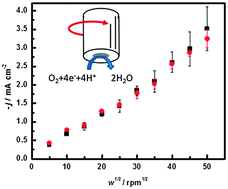Mass transport controlled oxygen reduction at anthraquinone modified 3D-CNT electrodes with immobilized Trametes hirsuta laccase
Abstract

* Corresponding authors
a
Chemistry, University of Southampton, Southampton, UK
E-mail:
pnb@soton.ac.uk
Fax: +23 8059 3781
Tel: +23 8059 2373
b
Interdisciplinary Nanoscience Center (iNANO), Faculty of Science, Aarhus University, Ny Munkegade 120, DK-8000 Aarhus C, Denmark
E-mail:
sosna@inano.au.dk
Tel: +45 8715 5838
c
Analytische Chemie - Elektroanalytik & Sensorik, Ruhr-Universität Bochum, Universitätsstr. 150, D-44780 Bochum, Germany
E-mail:
wolfgang.schuhmann@rub.de
Fax: +23 4321 4683
Tel: +23 4322 6200
d
The School of Biological and Chemical Sciences, Queen Mary, University of London, London, UK
E-mail:
j.kilburn@qmul.ac.uk
Fax: +20 7882 7732
Tel: +20 7882 3031

 Please wait while we load your content...
Something went wrong. Try again?
Please wait while we load your content...
Something went wrong. Try again?
M. Sosna, L. Stoica, E. Wright, J. D. Kilburn, W. Schuhmann and P. N. Bartlett, Phys. Chem. Chem. Phys., 2012, 14, 11882 DOI: 10.1039/C2CP41588G
To request permission to reproduce material from this article, please go to the Copyright Clearance Center request page.
If you are an author contributing to an RSC publication, you do not need to request permission provided correct acknowledgement is given.
If you are the author of this article, you do not need to request permission to reproduce figures and diagrams provided correct acknowledgement is given. If you want to reproduce the whole article in a third-party publication (excluding your thesis/dissertation for which permission is not required) please go to the Copyright Clearance Center request page.
Read more about how to correctly acknowledge RSC content.
 Fetching data from CrossRef.
Fetching data from CrossRef.
This may take some time to load.
Loading related content
